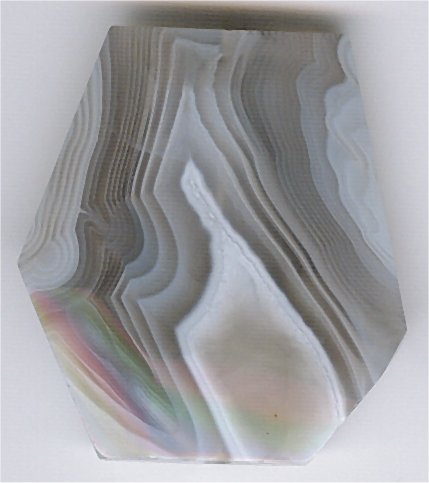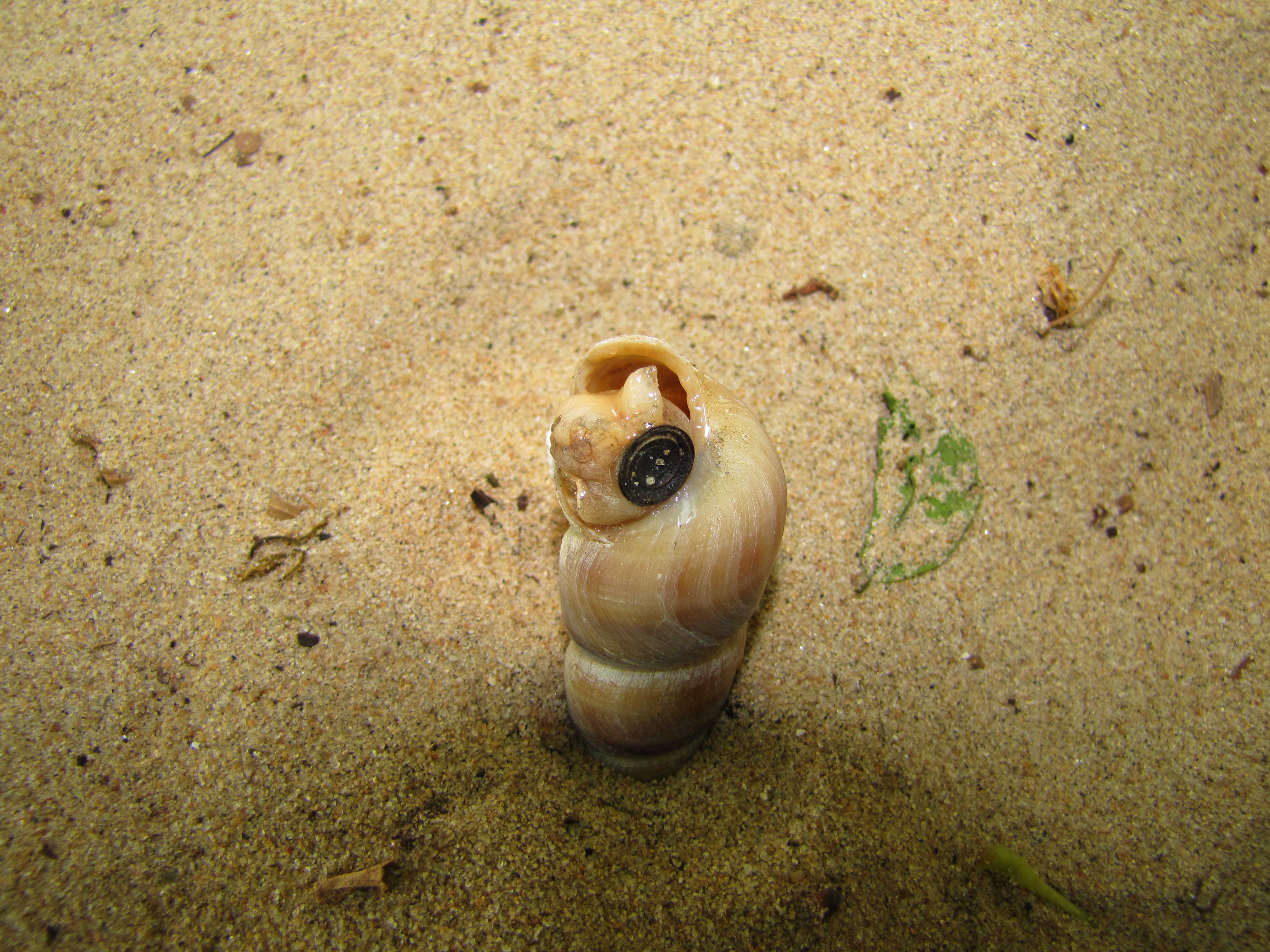|
Agate (mineral)
Agate () is a common rock formation, consisting of chalcedony and quartz as its primary components, with a wide variety of colors. Agates are primarily formed within Volcanic rock, volcanic and metamorphic rocks. The ornamental use of agate was common in Ancient Greece, in assorted jewelry and in the seal stones of Greek warriors, while bead necklaces with pierced and polished agate date back to the 3rd millennium BCE in the Indus Valley civilisation. Etymology The stone was given its name by Theophrastus, a Greeks, Greek philosopher and naturalist, who discovered the stone along the shore line of the Dirillo, Dirillo River or Achates ( grc, Ἀχάτης) in Sicily, sometime between the 4th and 3rd centuries BCE. Formation and properties Agate minerals have the tendency to form on or within pre-existing rocks, creating difficulties in accurately determining their time of formation. Their host rocks have been dated to have formed as early as the Archean Eon. Agates are most c ... [...More Info...] [...Related Items...] OR: [Wikipedia] [Google] [Baidu] |
Cryptocrystalline
Cryptocrystalline is a rock microstructure, rock texture made up of such minute crystals that its crystalline nature is only vaguely revealed even microscopically in thin section by transmitted polarized light. Among the sedimentary rocks, chert and flint are cryptocrystalline. carbonado (diamond), Carbonado, a form of diamond, is also cryptocrystalline. Volcanic rocks, especially of the felsic type such as felsites and rhyolites, may have a cryptocrystalline matrix (geology), groundmass as distinguished from pure obsidian (felsic) or tachylyte (mafic), which are natural rock glasses. Agate and onyx are examples of cryptocrystalline silica (chalcedony). See also * List of rock textures * Macrocrystalline * Microcrystalline * Nanocrystalline * Rock microstructure References Crystals Lithics Petrology concepts {{Petrology-stub ... [...More Info...] [...Related Items...] OR: [Wikipedia] [Google] [Baidu] |
Sicily
(man) it, Siciliana (woman) , population_note = , population_blank1_title = , population_blank1 = , demographics_type1 = Ethnicity , demographics1_footnotes = , demographics1_title1 = Sicilian , demographics1_info1 = 98% , demographics1_title2 = , demographics1_info2 = , demographics1_title3 = , demographics1_info3 = , timezone1 = CET , utc_offset1 = +1 , timezone1_DST = CEST , utc_offset1_DST = +2 , postal_code_type = , postal_code = , area_code_type = ISO 3166 code , area_code = IT-82 , blank_name_sec1 = GDP (nominal) , blank_info_sec1 = €89.2 billion (2018) , blank1_name_sec1 = GDP per capita , blank1_info_sec1 ... [...More Info...] [...Related Items...] OR: [Wikipedia] [Google] [Baidu] |
Turritella
''Turritella'' is a genus of medium-sized sea snails with an operculum, marine gastropod mollusks in the family Turritellidae.Vos, C.; Gofas, S. (2013). Turritella Lamarck, 1799. Accessed through: World Register of Marine Species at http://www.marinespecies.org/aphia.php?p=taxdetails&id=138615 on 2013-06-02 They have tightly coiled shells, whose overall shape is basically that of an elongated cone. The name ''Turritella'' comes from the Latin word ''turritus'' meaning "turreted" or "towered" and the diminutive suffix ''-ella''. Species Valid Valid species within the genus ''Turritella'' are listed below. Fossil species are marked with a dagger "†". * ''Turritella acropora'' (Dall, 1889) * '' Turritella albolapis'' Finlay, 1924 * '' Turritella algida'' Melvill & Standen, 1912 * '' Turritella anactor'' Berry, 1957 * ''Turritella annulata'' Kiener, 1843 * † '' Turritella apicalis'' - Pleistocene of Florida * ''Turritella attenuata'' Reeve, 1849 * '' Turritella aurocincta'' ... [...More Info...] [...Related Items...] OR: [Wikipedia] [Google] [Baidu] |
Elimia Tenera
''Elimia tenera'' in chalcedony from Wyoming ">Wyoming.html" ;"title="chalcedony from Wyoming">chalcedony from Wyoming ''Elimia tenera'', formerly known as ''Goniobasis tenera'', is an extinct species of freshwater snail with an operculum (gastropod), operculum, in the aquatic gastropod mollusk family Pleuroceridae. This species flourished during the Eocene and is now known only from the fossil record. The genus name ''Elimia'' was restored to this species in 1975; formerly it was placed in ''Goniobasis''. Green River Formation deposits Fossilized ''Elimia tenera'' shells occur in a region which is now southern Wyoming, northern Colorado and northeastern Utah. The best preserved ''Elimia tenera'' are from Lake Gosiute which fossils occur in the Fort Laclede Bed of the Laney Member at outcrops in Sweetwater County, in southwestern Wyoming. 'Turritella agate' The fossils are hosted in chalcedony rich sedimentary rock. This rock was originally incorrectly called ''Turritell ... [...More Info...] [...Related Items...] OR: [Wikipedia] [Google] [Baidu] |
Lace
Lace is a delicate fabric made of yarn or thread in an open weblike pattern, made by machine or by hand. Generally, lace is divided into two main categories, needlelace and bobbin lace, although there are other types of lace, such as knitted or crocheted lace. Other laces such as these are considered as a category of their specific craft. Knitted lace, therefore, is an example of knitting. This article considers both needle lace and bobbin lace. While some experts say both needle lace and bobbin lace began in Italy in the late 1500s, there are some questions regarding its origins. Originally linen, silk, gold, or silver threads were used. Now lace is often made with cotton thread, although linen and silk threads are still available. Manufactured lace may be made of synthetic fiber. A few modern artists make lace with a fine copper or silver wire instead of thread. Etymology The word lace is from Middle English, from Old French ''las'', noose, string, from Vulgar Latin *' ... [...More Info...] [...Related Items...] OR: [Wikipedia] [Google] [Baidu] |
Dolomite (rock)
Dolomite (also known as dolomite rock, dolostone or dolomitic rock) is a sedimentary carbonate rock that contains a high percentage of the mineral dolomite, CaMg(CO3)2. It occurs widely, often in association with limestone and evaporites, though it is less abundant than limestone and rare in Cenozoic rock beds (beds less than about 66 million years in age). The first geologist to distinguish dolomite rock from limestone was Belsazar Hacquet in 1778. Most dolomite was formed as a magnesium replacement of limestone or of lime mud before lithification. The geological process of conversion of calcite to dolomite is known as dolomitization and any intermediate product is known as dolomitic limestone. The "dolomite problem" refers to the vast worldwide depositions of dolomite in the past geologic record in contrast to the limited amounts of dolomite formed in modern times. Recent research has revealed sulfate-reducing bacteria living in anoxic conditions precipitate dolomite which ind ... [...More Info...] [...Related Items...] OR: [Wikipedia] [Google] [Baidu] |
Limestone
Limestone ( calcium carbonate ) is a type of carbonate sedimentary rock which is the main source of the material lime. It is composed mostly of the minerals calcite and aragonite, which are different crystal forms of . Limestone forms when these minerals precipitate out of water containing dissolved calcium. This can take place through both biological and nonbiological processes, though biological processes, such as the accumulation of corals and shells in the sea, have likely been more important for the last 540 million years. Limestone often contains fossils which provide scientists with information on ancient environments and on the evolution of life. About 20% to 25% of sedimentary rock is carbonate rock, and most of this is limestone. The remaining carbonate rock is mostly dolomite, a closely related rock, which contains a high percentage of the mineral dolomite, . ''Magnesian limestone'' is an obsolete and poorly-defined term used variously for dolomite, for limes ... [...More Info...] [...Related Items...] OR: [Wikipedia] [Google] [Baidu] |
Sedimentary Rock
Sedimentary rocks are types of rock that are formed by the accumulation or deposition of mineral or organic particles at Earth's surface, followed by cementation. Sedimentation is the collective name for processes that cause these particles to settle in place. The particles that form a sedimentary rock are called sediment, and may be composed of geological detritus (minerals) or biological detritus (organic matter). The geological detritus originated from weathering and erosion of existing rocks, or from the solidification of molten lava blobs erupted by volcanoes. The geological detritus is transported to the place of deposition by water, wind, ice or mass movement, which are called agents of denudation. Biological detritus was formed by bodies and parts (mainly shells) of dead aquatic organisms, as well as their fecal mass, suspended in water and slowly piling up on the floor of water bodies (marine snow). Sedimentation may also occur as dissolved minerals precipitate from ... [...More Info...] [...Related Items...] OR: [Wikipedia] [Google] [Baidu] |
Iron Oxide
Iron oxides are chemical compounds composed of iron and oxygen. Several iron oxides are recognized. All are black magnetic solids. Often they are non-stoichiometric. Oxyhydroxides are a related class of compounds, perhaps the best known of which is rust. Iron oxides and oxyhydroxides are widespread in nature and play an important role in many geological and biological processes. They are used as iron ores, pigments, catalysts, and in thermite, and occur in hemoglobin. Iron oxides are inexpensive and durable pigments in paints, coatings and colored concretes. Colors commonly available are in the "earthy" end of the yellow/orange/red/brown/black range. When used as a food coloring, it has E number E172. Stoichiometries Iron oxides feature as ferrous ( Fe(II)) or ferric ( Fe(III)) or both. They adopt octahedral or tetrahedral coordination geometry. Only a few oxides are significant at the earth's surface, particularly wüstite, magnetite, and hematite. * Oxides of FeII ... [...More Info...] [...Related Items...] OR: [Wikipedia] [Google] [Baidu] |
Vesicle (geology)
Vesicular texture is a volcanic rock texture characterized by a rock being pitted with many cavities (known as vesicles) at its surface and inside. This texture is common in aphanitic, or glassy, igneous rocks that have come to the surface of the earth, a process known as extrusion. As magma rises to the surface the pressure on it decreases. When this happens gasses dissolved in the magma are able to come out of solution, forming gas bubbles (the cavities) inside it. When the magma finally reaches the surface as lava and cools, the rock solidifies around the gas bubbles and traps them inside, preserving them as holes filled with gas called vesicles. A related texture is amygdaloidal in which the volcanic rock, usually basalt or andesite, has cavities, or vesicles, that are filled with secondary minerals, such as zeolites, calcite, quartz, or chalcedony. Individual cavity fillings are termed amygdules (American usage) or amygdales (British usage). Sometimes these can be source ... [...More Info...] [...Related Items...] OR: [Wikipedia] [Google] [Baidu] |
Volcanic Rock
Volcanic rock (often shortened to volcanics in scientific contexts) is a rock formed from lava erupted from a volcano. In other words, it differs from other igneous rock by being of volcanic origin. Like all rock types, the concept of volcanic rock is artificial, and in nature volcanic rocks grade into hypabyssal and metamorphic rocks and constitute an important element of some sediments and sedimentary rocks. For these reasons, in geology, volcanics and shallow hypabyssal rocks are not always treated as distinct. In the context of Precambrian shield geology, the term "volcanic" is often applied to what are strictly metavolcanic rocks. Volcanic rocks and sediment that form from magma erupted into the air are called "volcaniclastics," and these are technically sedimentary rocks. Volcanic rocks are among the most common rock types on Earth's surface, particularly in the oceans. On land, they are very common at plate boundaries and in flood basalt provinces. It has been estimated t ... [...More Info...] [...Related Items...] OR: [Wikipedia] [Google] [Baidu] |


_DxO.jpg)


